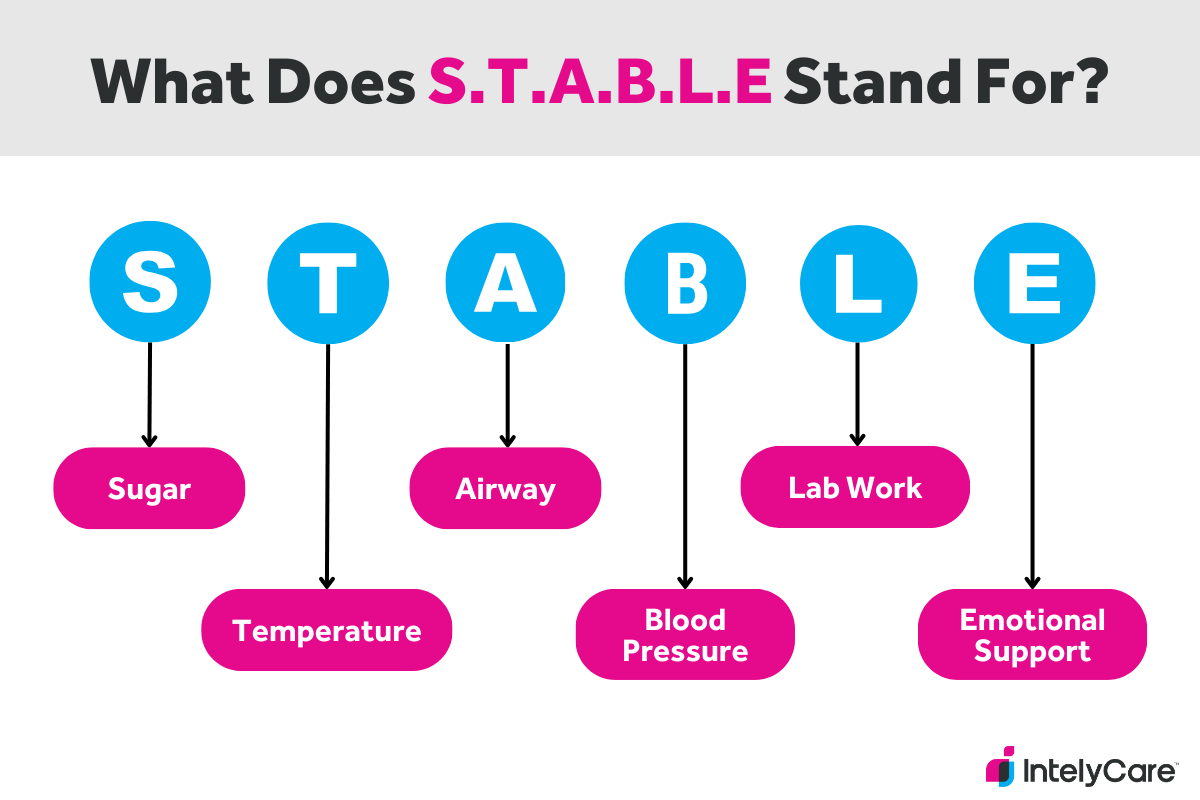S.T.A.B.L.E. Certification: Overview and FAQ

Do you know what to do if an infant stops breathing? What if their temperature is abnormally low? If you’re a neonatal clinician or are thinking about becoming one, a S.T.A.B.L.E. certification could help you gain confidence and add authority to your resume. But what goes into earning your S.T.A.B.L.E. certificate? Here’s what you need to know.
Among high-income countries, the United States’ infant and maternal mortality rates are the highest in the world. Experts believe this could be due to failures in prenatal care.
You’ve likely heard about measures to mitigate these failures, like the pediatric advanced life support (PALS) certification or the neonatal resuscitation program (NRP) course, but what happens after babies are resuscitated? Becoming S.T.A.B.L.E. certified can help you care for these patients with more confidence. While this credential especially benefits neonatal nurses, it’s designed to help other members of the health team, including:
- Emergency department nurses
- Emergency medical technicians (EMTs)
- Labor and delivery nurses
- Licensed practical nurses (LPNs)
- Nurse midwives
- Paramedics
- Pediatric nurses
- Physicians
- Respiratory therapists
What Is S.T.A.B.L.E. Certification?

S.T.A.BL.E. is a medical certification that verifies a clinician’s skills in supporting infants after resuscitation, before they’ve been transported to a higher level of care. The acronym stands for the six care components the program teaches:
1. Sugar: This module covers glucose homeostasis in newborns.
- Risk factors for neonatal hypoglycemia
- Proper glucose screening techniques
- Signs and symptoms of hypoglycemia
- Treatment options, including enteral feeding and intravenous glucose administration
- Indications for umbilical catheter use
2. Temperature: Maintaining a newborn’s body temperature is crucial. This section covers:
- Mechanisms of heat loss in newborns
- Consequences of cold stress
- Methods to reduce heat loss during resuscitation and transport
- Techniques for rewarming hypothermic infants
3. Airway: Respiratory management for neonatal patients:
- Evaluating respiratory distress and respiratory failure
- Understanding common neonatal respiratory diseases
- Airway challenges in the neonatal patient
- Pneumothorax detection and treatment
- Interpreting arterial blood gases
- Implementing respiratory support in the newborn
4. Blood pressure: Maintaining adequate perfusion is essential. You’ll learn the following:
- Causes and types of shock in newborns
- Recognition of compensated and decompensated shock
- Fluid management in neonatal shock
- Monitoring blood pressure in infants
5. Lab work: This section focuses on neonatal sepsis and infection control.
- Risk factors for neonatal sepsis
- Signs and symptoms of infection in newborns
- Interpretation of laboratory tests (i.e., CBC, blood cultures)
- Antibiotic therapy in neonatal care
- Importance of timely treatment in sepsis management
6. Emotional support: Families need support when their infant is sick. The course covers a range of topics:
- Impact of hospitalization on families
- Effective communication with parents and family members
- Strategies to support parent-infant bonding in the NICU
- Addressing parental grief and anxiety
- Resources for ongoing family support
7. Quality Improvement: This module focuses on patient safety and team performance.
- Effective communication and teamwork
- Eliminating errors
- Providing safe, quality care
S.T.A.B.L.E. Course Format Options
The S.T.A.B.L.E. program is available in both online and in-person formats. The online course can be completed on your schedule, while in-person courses provide hands-on learning experiences with less flexibility.
S.T.A.B.L.E. online learning:
- Self-paced learning through HealthStream
- Includes interactive modules and video demonstrations
- Typically takes about 5.5 to 6 hours to complete
- Cost: $165
S.T.A.B.L.E. learner course:
- Instructor-led classroom sessions
- Hands-on practice with case studies, simulations, and quizzes
- Usually completed in 1 to 2 days day (approximately 8 hours)
- Cost depends on the training facility
S.T.A.B.L.E. Quiz and Exam Formats
To pass S.T.A.B.L.E., you’ll need to pass both the module quizzes and the posttest.
Module quizzes (32 questions) come directly after each module. Students will have three chances to pass each quiz, and if you don’t pass the first two times, your instructor will review the content with you. The instructor will record scores, and these will be entered along with the course roster after the class.
The course posttest (8 questions) covers all of the module content, and retests are not allowed. Here’s how the posttest is graded:
- 2 or fewer questions wrong (75% or more): Passing grade.
- 3 or 4 questions wrong (50–62.5%): Instructor must review incorrect answers with the student and decide if they grasp the information and should be passed.
- 5 or more wrong (37.5% or less): Failing grade. The student must repeat the course and test again.
S.T.A.B.L.E. Resources
While the S.T.A.B.L.E. course provides training on hands-on skills, you might prefer to keep some resources on hand or in your unit library, such as:
- S.T.A.B.L.E. Program Learner Manual, 6th edition
- S.T.A.B.L.E. Cardiac Manual, 2nd edition
- S.T.A.B.L.E. program videos
- Candidacy for therapeutic hypothermia
- Cooling neurologic exam
- The Stabilization Quality Improvement Tool (PSSAT)
- S.T.A.B.L.E.ize App
Getting Your S.T.A.B.L.E. Nursing Certification: 4 Steps
Step 1: Purchase the S.T.A.B.L.E. Program
To get started, you’ll purchase the online course from Nursegrid or another provider. If you’re looking for an in-person class, you can contact an instructor in your region. Sometimes facilities and units will pay for this training, so it might be free.
Step 2: Complete the Course
Go through the course materials, which include at least five and a half hours of continuing education credits. Remember that while the course teaches a broad range of skills and knowledge, it doesn’t change your scope of practice. It’s your responsibility to know your scope and adhere to it within the subject material.
Step 3: Pass the S.T.A.B.L.E. Post-Test
The online materials include a certification exam, and you’ll need a score of at least 75% to pass. If you have a nursing license, you’ll need to provide your license number for record-keeping.
Step 4: Maintain Your Certification
How long does S.T.A.B.L.E. certification last? To keep this credential active, you’ll need to complete S.T.A.B.L.E. certification renewal every two years. To renew in person, you can either take the course again or take a shortened version of the course. You can also renew remotely by taking the full online program again.
S.T.A.B.L.E. Certification: Cost Considerations
The online S.T.A.B.L.E program cost is $165 and includes a certification exam. If you’d like to refer back to the information while away from the computer, you might also purchase the learner manual for $65. However, you might not need to pay for the course. If you work at a teaching hospital or another larger medical facility, ask your supervisor if a S.T.A.B.L.E. course is being offered soon.
S.T.A.B.L.E. FAQs
S.T.A.B.L.E. vs. BLS: What’s the difference?
The basic life support (BLS) program is a standard resuscitation training that every clinical team member must go through in order to practice. It covers life-saving basics like cardiopulmonary resuscitation (CPR), rescue breaths, and using an automatic external defibrillator (AED). BLS includes protocols for infants, such as choking and infant CPR, but S.T.A.B.L.E. brings a deeper, more advanced understanding of post-resuscitation care.
S.T.A.B.L.E. vs. PALS: What’s the difference?
The pediatric advanced life support (PALS) training is an advanced program for clinicians who work with children and infants who are medically unstable. It covers shock, respiratory and cardiac emergencies, and how to care for patients after they’ve been successfully resuscitated. S.T.A.B.L.E. focuses more deeply on neonatal care after resuscitation and covers a broader range of topics in this area.
S.T.A.B.L.E. vs. NRP: What’s the difference?
The neonatal resuscitation program (NRP) is a set of guidelines for infant resuscitation. It’s specifically for infants, so it’s essential for nurses who work in the NICU and other infant units. If you don’t yet have your NRP certification, it’s recommended that you obtain it before pursuing S.T.A.B.L.E.
Can I become a S.T.A.B.L.E. certification instructor?
The following professionals are eligible to become S.T.A.B.L.E. instructors:
- Neonatologists
- Neonatal nurse practitioners
- Pediatricians with experience in neonatal intensive care
- Neonatal physician assistants
- Neonatal transport nurses
- NICU clinical nurse educators and specialists
- Neonatal transport respiratory therapists
- Respiratory therapists with extensive experience in neonatal care
- Outreach educators with intensive care nursery backgrounds
- Experienced intensive care nursery (ICN) and NICU nurse preceptors
Related Certifications
- Basic Life Support (BLS)
- Neonatal Resuscitation Program (NRP)
- Pediatric Emergency Assessment, Recognition, and Stabilization (PEARS)
- Emergency Nursing Pediatric Course (ENPC)
- Pediatric Nursing Certification Board (PNCB Certification)
- Pediatric Advanced Life Support (PALS)
- Advanced Cardiac Life Support (ACLS)
- Critical Care Registered Nurse – Neonatal (CCRN Neonatal)
- Certified Emergency Nurse (CEN)
Opportunities for Neonatal Nursing Professionals
If you’re considering getting your S.T.A.B.L.E. certification, you might also be thinking about other ways to advance your career. IntelyCare’s tailored nursing job notifications put you in the know when it comes to open roles in your area.
